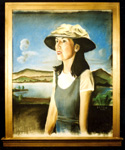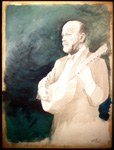Click to enlarge:
My portrait painting began my first year at University. At one time I thought to be a professional artist and began pursuing galleries, but this whim gave way to Lutherie as my creative outlet. I still draw for fun and have had a couple of recent commissions, but this is mainly a diversion.
Click here for my painting portfolio
Portraits.
. . .description
to come. . .

. . .description
to come. . .
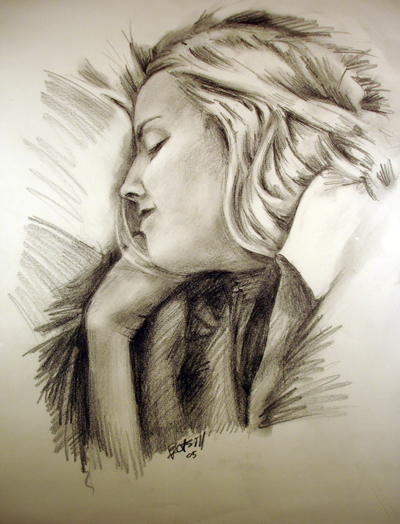
. . .description
to come. . .
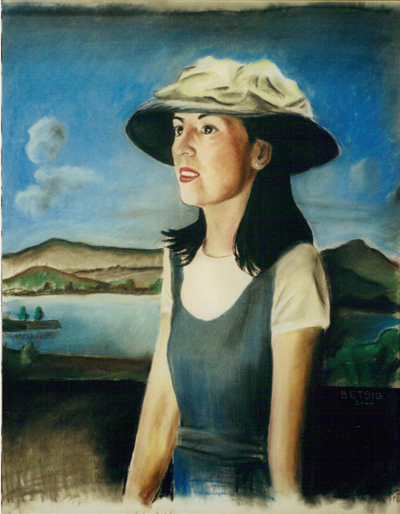
. . .description
to come. . .
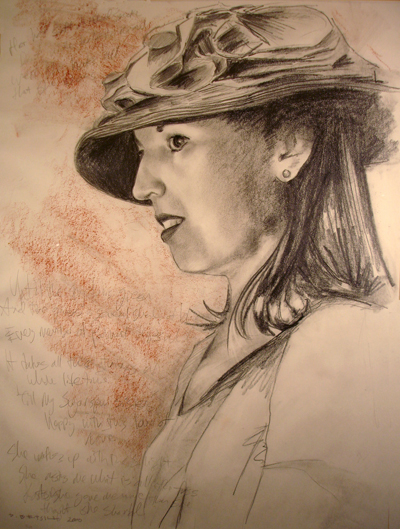
+++++
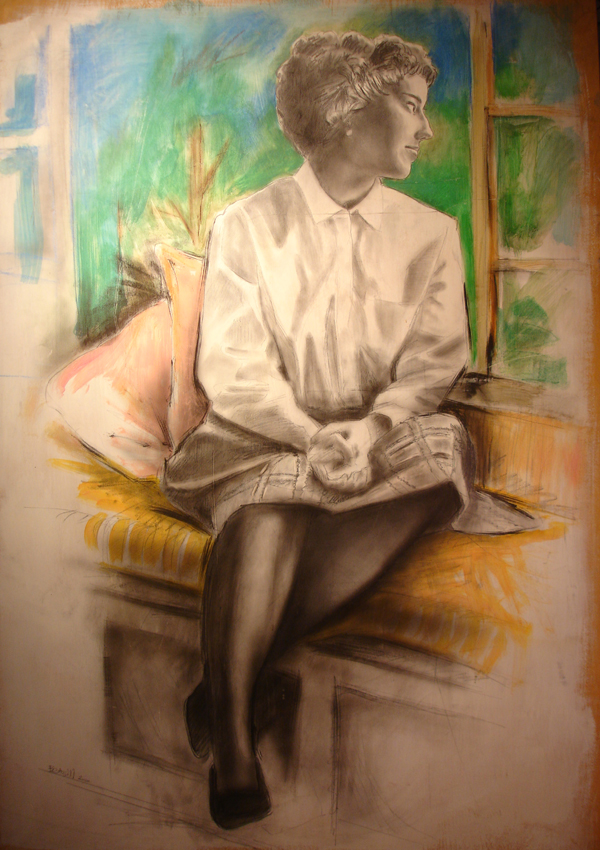
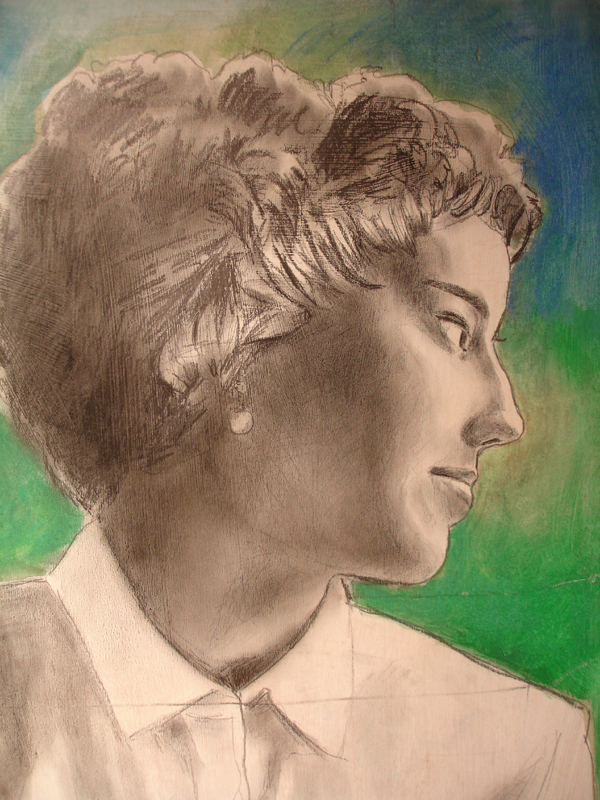
An unfinished painting
+++++
Landscapes.
Most of
my landscapes have been pen and ink sketches on vacations. The following
are the process images of a scene from the intracoastal waterway near
Flagler Beach, Florida I did as acrylic on canvas.

Cartooning the image with graphite on the canvas
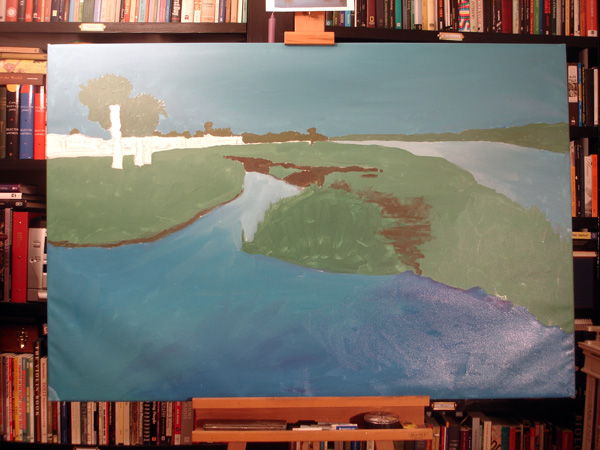
The underpainting

Developing the shadows
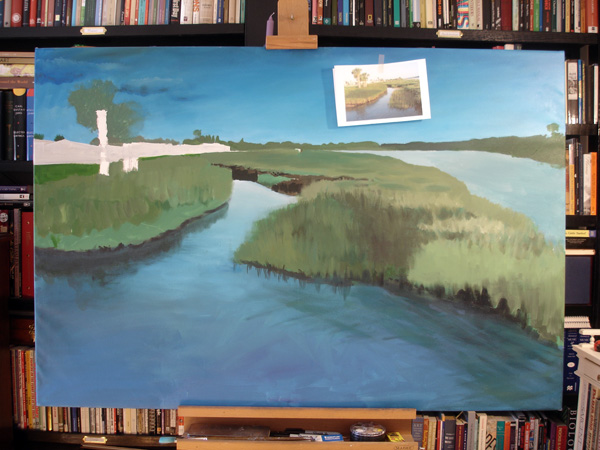
Starting to differentiate between the two main types of plantlife: the tall grass and the scrub

Starting to develop the buildings

Developing the palm trees and adding detail to the foreground plants and the coastline
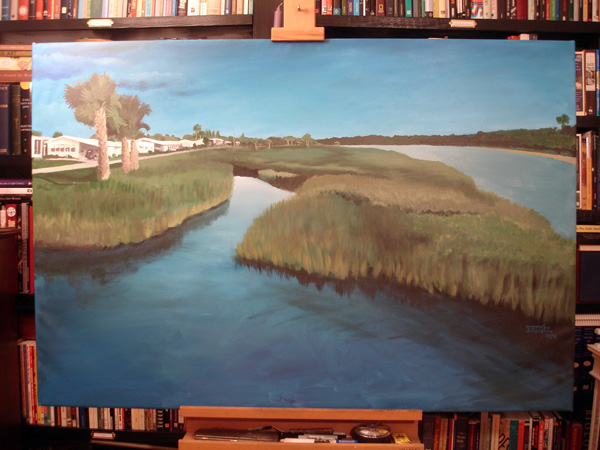
The completed painting with the final detail on the buildings
+++++
Funny.

+

=

Daisy as she always imagined herself. With favorite chew toy.
+++++
Set Design.
Over the
years I have been involved with several local production companies in
designing and sometimes fabricating sets.

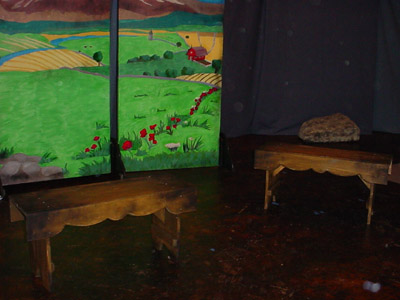
A pieced-together picture of my backdrop design for the Offshoot production of "The Pied Piper". Three light-weight plywood panels with 2x2 framework. The flash from the camera doesn't help the depth. The project also included two antiqued provencial benches.


Working on a prop bench for this year's church play. I'm experimenting with spray-on drwall texture to create a stone-look surface.
++++++
A Commission.
Occasionally
I will get commissions for specific subjects. The following are excerpts
from my proposal letter and some details for what to date is my largest
work, from 2004. In the letter I am exploring a shortlsit of subject matter
for a piece to be hung in a church sanctuary. In the letter I describe
my style and working methods.
Terminology: This painting, due to it's large size of roughly 8'x10' I would term a large-scale religious painting, and not an Icon as has been previously mentioned. Icons were meant chiefly to be a manageable size for transport, and also consisted of a single subject, residing in the picture plane, meaning the picture has no depth or three-dimensional qualities, which I am sure you would desire.
Size and Location: The piece would reside over the rear exit of the sanctuary. Due to the large blank area, the piece could truly be either vertical or horizontal orientation. Therefore, this choice should be dictated by the subject matter. A scene involving a landscape would want horizontal. A large central figure would want vertical. The size of the piece, being roughly 8'x10', would necessitate the painting being in two pieces to facilitate getting through the door. The construction would be such that fasteners in the back frame would join the two panels and the seam would almost disappear within the painting. When installed, a continuous strip of wood frame would be run up the sides and again on the ends to further shore the construction.
Subject Matter: Considering the intended location, seen as one leaves the sanctuary, and the most overt qualities of St. Teresa's, that of outreach, a vivacious, alive parish, regardless of subject matter I feel the painting must be: uplifting, beautiful, breathtaking, inspiring, lively. Subject matter we discussed was: 1) The feeding of the multitudes with loaves and fishes as described in John 6; 2) The life of St. Teresa; 3) The story of the marriage feast in which "the poor, the crippled, the blind and the lame" were welcomed, as described in Matthew 22 and Luke 14; 4) Peter and the apostles witnessing Christ walking on water. As to the execution, I feel the story should be told in a way that is between two extremes, one of the Icon quality of a flat picture plane, the other being a scene, as with a landscape: The former being too monotonous and simplistic, the latter being too diffuse and potentially bland. My personal inclination, as seen in the examples of my portfolio, is to create an arrangement of figures and scenes that may occupy the same space but exist in different consciousnesses. A central figure or group of figures is conveying a story or idea while accompanying figures or scenes or patterns invoke an emotion and support the central action. Lastly and importantly, the painting should incorporate an "everyman" figure, being a device with which the viewer can relate, placing the viewer in his or her place in the painting.
Materials: I am accustomed to working on board rather than canvas. Wood board was a traditional alternative to canvas for the Masters and is, needless to say, more durable. The contemporary would be 3/8" birch plywood, heavily gessoed (a leveling underpainting), with an applied hidden wood frame behind. The medium will invariable have to be oil for the work's large size. However, I anticipate adding encaustic (a heavy modeling paint) to achieve texturing, as well as gold leaf. Simulated leaf has the same appearance as the real thing and costs much less. A low-gloss varnish will protect the painting and prevent glare.
Subject One: "The feeding of the multitudes" is a scene depicting Christ as the central figure in a quietly commanding, outstretched pose with Mary and some apostles in close company. It is the moment of John 6:9, "Let the people sit down." The sea and the field and the mountain will be present in the background. Groups of followers are in the mid-ground. The scene would be enhanced by side panels, as in a triptych, with representations of, perhaps, St. Teresa, St. Gregory, or another figure of significance for the Parish.
Subject Two: St Teresa is indeed an engaging figure and could represent all the ideas expressed at the beginning of this letter. I have sketched two concepts: both of her as central figure, slightly larger than life-size, ascending and holding a tambourine (as you know is customary in representations of the saint). In one, she ascends in the foreground with arms and eyes up to the promise of Heaven and is accompanied by some of the faithful, her followers, in various states of repose and uplifting. An interesting mix of archaic and modern dress would be slightly surreal and quite effective in drawing her life into modern times. Message: she is living now and a very present force that is calling us to fulfill God's call to us. The reward is the righteous glory of the heavens depicted in the background. In the mid ground, in a separate consciousness, are figures representing the communion of saints, i.e., our forbearers who we emulate and who have joined the heavenly kingdom. A variation on this theme is the second sketch which shows her, in contrast, ascending but with eyes cast down on her faithful. The heavenly glory is reduced in scope to light emanation and focuses more on the figures of the faithful who should represent the poor, the downtrodden and the hopeful.
Subject Three: "The marriage feast" is the moment when the king welcomes "the poor, the crippled, the blind and the lame" to the banquet. We see the figure of the king greeting these people in the foreground. Also in the foreground, in a separate consciousness, is the risen Christ, who is presiding with outstretched arms over the scene as if to sanction the activity as the fulfillment of his teaching. In the mid-ground are ascending figures of the communion of saints that could include Mary, Teresa, Peter, etc. In the background are the city walls from whence the new guests have come.
Subject Four: A scene of the apostles witnessing Christ walking on the torrent waters. We see the instant where Peter takes his first step out of the boat with outstretched arms towards Christ. The visual center of the painting is Peter, as well as two other apostles in the boat: one pointing in disbelief at Christ, the other, more in shadows, perhaps looking back at the viewer with an expression of wonder. This is the "Everyman" in this particular scene. The spiritual center of the piece is Christ in the mid-ground on the water with a sprite of light emanating from his head. In the background is the city. The painting is generally dark, with city lights, and perhaps a moonglow lighting Peter and part of the boat. Above Christ in the background are an angel and the North Star. In a separate consciousness again are ascending saints, one potentially being Teresa.
Of these subjects, I feel St. Teresa is the most compelling and has the
greatest potential to embody the guidelines laid out at my introduction.
I, of course, await your decision and further input to arrive at
the message you wish to convey in this important addition to your worship
space. 
+++++
Detail from 'Audra D'anne Reeves', 74"x30", 1991
'Spring' (Stephanie Zarin), 42"x34", acrylic, goauche and graphite
on paper, 1993
Jenny Ward (unfinished), acrylic on board, 1999
Study of Karen MacKenzie, pastel, 1999
Study of Karen Zimmer, graphite, 1995







